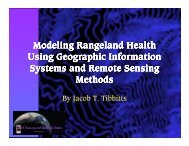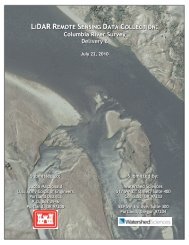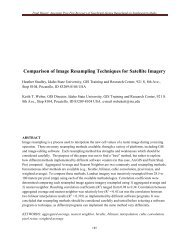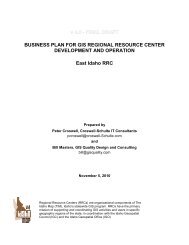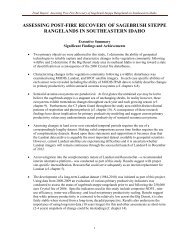A Multiscale Curvature Algorithm for Classifying Discrete Return ...
A Multiscale Curvature Algorithm for Classifying Discrete Return ...
A Multiscale Curvature Algorithm for Classifying Discrete Return ...
You also want an ePaper? Increase the reach of your titles
YUMPU automatically turns print PDFs into web optimized ePapers that Google loves.
1030 IEEE TRANSACTIONS ON GEOSCIENCE AND REMOTE SENSING, VOL. 45, NO. 4, APRIL 2007in the case of LiDAR, change its amplitude (deviation from surroundingpoints) [11]. All of these behaviors occur in LiDARpoint clouds as a classification/filtering model is applied.Changing object topology across scales argues <strong>for</strong> an iterativemultiscale model applied directly to the LiDAR point cloud.<strong>Algorithm</strong>s that identify nonground returns based on curvaturethresholds within local neighborhoods appear robust<strong>for</strong> separating ground from nonground in unclassified LiDARpoint clouds in <strong>for</strong>ested environments, particularly in complexterrain [3]. Previous attempts to account <strong>for</strong> slope and scaleeffects have used variable window sizes or weighting functionsto address the interactions of topography and vegetationon LiDAR returns [12]–[15]. However, these methods havebeen most effective <strong>for</strong> classifying nonground returns in gentleterrain, open canopy, or urban environments, rather than in,perhaps, the most challenging environment of densely <strong>for</strong>estedcomplex terrain.<strong>Curvature</strong> approaches identify positive local deviations fromsurrounding points and then iteratively classify them as nonground.Haugerud and Harding [3] presented a virtual de<strong>for</strong>estation(VDF) algorithm based on identifying positive localcurvatures in an interpolated triangulated irregular network(TIN) constructed from LiDAR point data. Once curvatures areidentified, TIN nodes that exceed a defined threshold are iterativelydeleted, and the model is run again with the remainingdata until a convergence threshold is met. Interpolation of TINmodels is based on a linear weighting function applied to avector connecting adjacent points [16]. In complex terrain, thiscan distort surface morphology, often resulting in large errors[17]. These commission and omission errors can add noise tothe surface, particularly in settings with steep slopes and highcanopy density.We present multiscale curvature classification (MCC), anautomated approach <strong>for</strong> classifying LiDAR returns that incorporatesthe strengths of curvature filtering [3], adds a scalecomponent in the interpolation phase, and a variable curvaturetolerance to account <strong>for</strong> slope interaction with the LiDARmeasurements [3]. The model iteratively classifies nongroundLiDAR returns that exceed positive curvature thresholds atmultiple scales. The three primary improvements of the MCCmodel on the VDF model are given as follows: 1) thin-platespline (TPS) interpolation [18], [19]; 2) integration of a multiscaleapproach where the surface is interpolated at differentresolutions; and 3) a progressive curvature tolerance. UnlikeTIN, TPS interpolation allows <strong>for</strong> adjustment of tension betweenpoints, providing adherence to input data and controllingthe distance at which point samples affect the surface estimates[20]. The spline tension parameter f also reduces large deviationsin the surface between sample points, effectively reducingnoise [20]. Inclusion of a multiscale approach more comprehensivelyaddresses topological relationships of nonground objectsacross variable scales. Because the surface is generalized asthe scale parameter is changed, it is necessary to change thecurvature threshold parameter, effectively addressing changesin slope effect as the data are generalized. In summary, MCCis an automated algorithm that iteratively identifies nongroundpoints that exceed positive curvature thresholds across multiplescales in unclassified LiDAR point clouds.Fig. 1.Location map of the two LiDAR survey areas and test sites.II. OBJECTIVESThe primary goal was to automatically, objectively, andconsistently identify ground returns from unclassified LiDARpoint clouds. Four criteria were applied in developing the MCCalgorithm. The first was flexibility across different LiDAR data<strong>for</strong>mats. The MCC algorithm requires only the X, Y , and Z coordinatesas inputs, the three most basic components commonto all discrete return LiDAR data sets. The second criterion wassimplicity in model parameters. Overly complex or numerousmodel parameters can introduce subjectivity or result in lackof repeatability. However, the only user-defined parameters inthe MCC algorithm are the initial scale and curvature toleranceparameters. The third criterion was that the model be fullyautomated, i.e., the user need not intervene during the classificationfiltering process, which can also introduce subjectivity.Finally, the algorithm should preclude or minimize the need <strong>for</strong>postprocessing, which can be a very time-consuming, costly,and subjective process. The MCC algorithm was designed toobjectively, reliably, and repeatability identify ground returnswith minimal to no need <strong>for</strong> manual postprocessing, fromany discrete return LiDAR data set acquired over a <strong>for</strong>estedenvironment.A. Study AreaIII. METHODSThe two LiDAR survey areas used in this paper, MoscowMountain and the Saint Joe Woodlands in north central Idaho(Fig. 1), comprise 88 000 ha of mixed conifer <strong>for</strong>est with amixture of industrial <strong>for</strong>est, private, state, and federal ownerships.Both areas are highly relieved with more topographiccomplexity in the St. Joe Woodlands. Conifer species vary fromPinus ponderosa at xeric sites to Tsuga heterophylla in mesicsettings. Other common conifer species include Abies grandis,Abies lasiocarpa, Larix occidentalis, Picea engelmannii,Pinus contorta, Pinus monticola, Pseudotsuga menziesii, andThuja plicata, which create diverse <strong>for</strong>est compositions acrossbroad temperature and moisture gradients. The canopy and age





